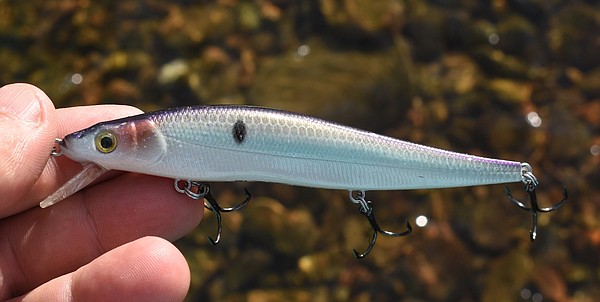If you like easy fishing and fast catching, a white bass trip is just what you need over the next few weeks.
Right now, white bass are making their spawning runs into tributaries of all our lakes and major rivers. They are concentrated in narrow, shallow water, and they will hit a wide assortment of artificial lures. If you can cast and retrieve, you can catch white bass just about anywhere.
TACKLE
In Arkansas, a really big white bass weighs about 3 pounds, but they average about 13 inches long. High or low, they are the ideal size for light and even ultralight tackle. On 6-pound test line, they’ll give a light, limber rod all it can handle. For even more fun, use 4-pound test line.
A spinning rig with a 6-foot rod is ideal. A white bass strikes fast and hard, and even a small one can break light line on the strike if your drag is too tight. The fish will hook itself on the strike and then surge with even greater force than the strike. Your drag should be solid for the strike and then release slightly for the run. Since white bass are pelagic, you don’t have to worry about them breaking you off in cover. They will stay in open water, allowing you to fight them freely.
LURES
A white bass will bite anything that remotely resembles a threadfin shad or minnow. Select a heavy lure that you can cast a long distance. Choice selections are Blue Fox and Vibrax inline spinnerbaits and small spoons. Inline spinners and spoons twist when retrieved, and they will ultimately twist and foul line. You can avert this by using a swivel and a 12-inch leader.
Small swimbaits or sassy shad type soft plastic lures are excellent for white bass. A 1/8- or 1/4-ounce ball head jighead or swimbait head will allow you to cast sufficient distances. A simple retrieve is all it takes.
A variation of this technique involves twister tail grubs. A tandem rig works best with a white grub on one line and a yellow or chartreuse grub on the other line. White bass often ignore just one twister tail, but they won’t ignore two. You might even catch two fish at once.
Topwater fishing is the most exciting way to catch white bass. When schooling, white bass will slam topwater lures ferociously. Any small topwater will work, including the Heddon Tiny Torpedo, a small Rebel Pop R or an Excalibur Zell Pop. Retrieve cigar style lures, like the Zara Puppy, in a serpentine, walk-the-dog fashion. Retrieve chugger style lures quickly so that they spit water. The spitting action excites fish, and you can sometimes catch two at a time.
Trolling is another great way to catch white bass when fishing thin water. A 3-inch stickbait is excellent for catching all sizes of white bass. It will also catch striped bass, but you can land massive stripers on ultralight tackle with proper drag control.
Fly fishing is a fantastically fun way to catch white bass in the spring. A white bass will bite any white streamer or even an ultralight jig and give you the fight of your life on a 3-weight fly rod.
Finally, you can also catch white bass on bait. Small crawdads are excellent, as are thawed popcorn shrimp and small, canned clams.
LAKE MAUMELLE
In Central Arkansas, the upper portion of Lake Maumelle offers excellent fishing. The action starts at the Hwy. 10 Bridge and progresses upstream into the Big Maumelle River. The spawning run climaxes in the skinny water at the public access on Arkansas 10 above the bridge.
Good fishing is available from the bank at the peak of the spawning run, but it’s better from a kayak or even a canoe if the current is not too strong.
LAKE ATKINS
Though best known for trophy largemouth bass, Lake Atkins supports a large white bass population. The water is so clear that you can actually see the schools moving along the flats. They look like big shadows. That’s the best time to fly fish for them, but it’s always good to have a spinning rig ready when they get a notion to chase bait on the surface.
LAKE NIMROD
Go as far up the Fourche La Fave River as you can to enjoy the peak of the white bass spawning run at Lake Nimrod, but don’t overlook the smaller creeks that feed the lake. White bass will advance to the fall line, where they will concentrate in ridiculously skinny water. This is as close as you can get to fishing in a barrel, and when they go on a feeding frenzy, you can catch them as fast as you can cast.
LAKE OUACHITA
Pick any tributary you want on this giant reservoir between Hot Springs and Mt. Ida. White bass are in all of them.
Right now, they are still in fairly wide water following river channels and creek channels. On March 13, 2020, I fished with Stephen Dunlap in a main arm and caught dozens of white bass. They schooled in spurts as they moved back and forth from the channel to the flats. We caught them half a dozen at a time. They’d vanish into the channel and then come back 15-20 minutes later. None were big, but they kept us busy all afternoon.
BEAVER LAKE
The second reservoir in the White River chain hosts one of the most prolific white bass runs in Arkansas. They behave similarly to Lake Ouachita in War Eagle Creek, Hickory Creek, Indian Creek and the White River arm. If the water gets high enough, you can catch white bass almost to the dam at War Eagle Mill.
TABLE FARE
White bass are delicious to eat fresh, but they are labor intensive. Even a big white bass yields a very small fillet that shrinks considerably when you remove the blood line. Leaving the bloodline gives the fish a very strong flavor that many consider unpalatable.
My experience is that white bass fillets do not keep well frozen. Keep only enough to eat fresh and come back for more later.
Fried fillets are very tasty. They are also very good stir fried in butter.
The spawning pattern lasts well into April, but the fish will quickly migrate back into the lakes. The best surface action takes place in the summertime on open water.
Credit: Source link































